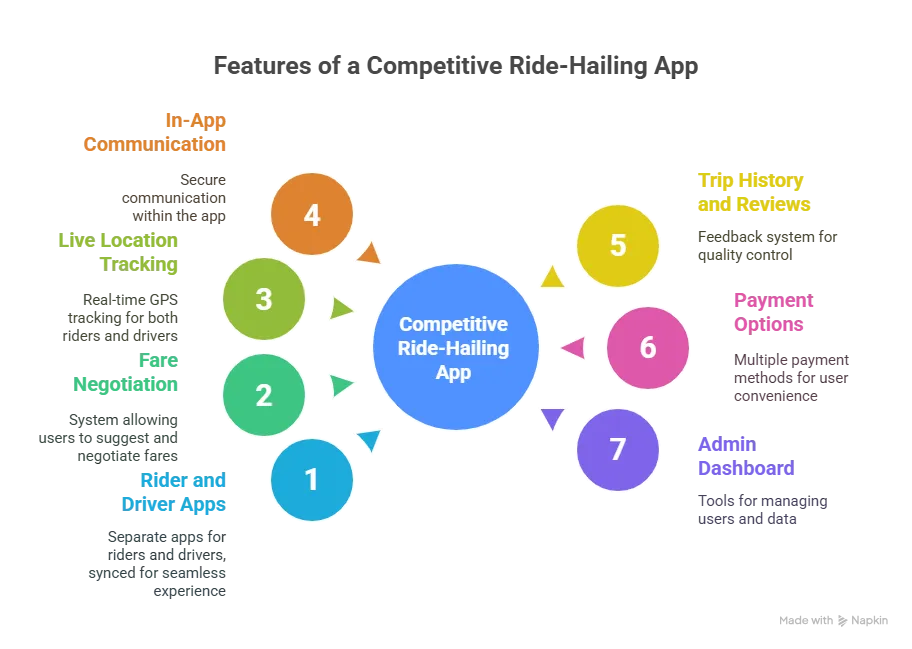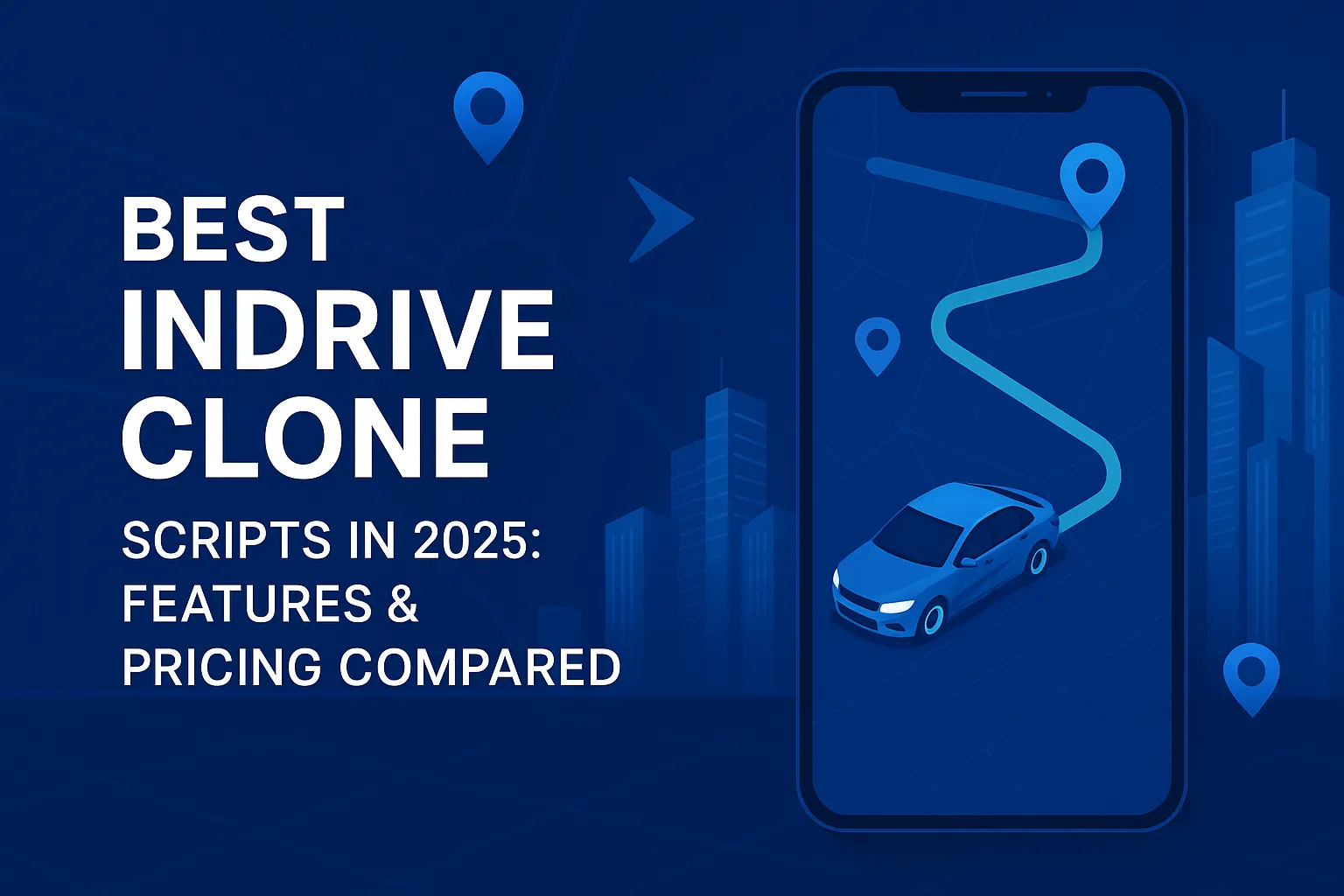A few years ago, getting into someone’s car for a ride across town might’ve sounded sketchy. Now? It’s a daily ritual. But here’s the twist — people don’t just want rides anymore. They want control, transparency, and a fair price. That’s why Indrive’s unique model—where riders and drivers negotiate the fare—has become such a hit in emerging markets.
If you’re an entrepreneur, startup founder, or even a local cab fleet owner, you’ve probably thought: “Can I build something like that?” Spoiler alert: You can. And no, you don’t need to code it from scratch or raise millions. All you need is a solid Indrive clone scripts —fast to deploy, flexible to grow, and packed with ride-matching magic.
At Miracuves, we’ve worked with founders across continents to launch next-gen ride-hailing platforms that give Uber and Lyft a run for their money. And in this guide, we’ll compare the top Indrive clone options of 2025—features, pricing, and everything in between.
What Is an Indrive Clone, Anyway?
Let’s get this straight: an Indrive clone app isn’t a cheap knockoff. It’s a pre-built, fully customizable ride-hailing platform inspired by Indrive’s core concept — where riders suggest a fare and drivers can accept, reject, or counter-offer. It blends marketplace dynamics with real-time transportation.
It’s ideal for:
- Startups in cities underserved by Uber or Bolt
- Regional taxi associations going digital
- Entrepreneurs targeting student or budget-conscious riders
- Fleet operators looking to scale sustainably
Unlike fixed-price apps, Indrive-style clones offer a fare negotiation feature, which not only empowers users but also builds trust between both sides of the transaction.
Read More : InDrive App Features: What Sets It Apart
Must-Have Features in the Best Indrive Clone Scripts

If you’re stepping into the ride-hailing arena in 2025, you’ll need more than just maps and meters. Here’s what to expect from a competitive Indrive clone:
1. Rider and Driver Apps (Separate, Yet Synced)
Two apps, two interfaces — one seamless experience. Riders request, drivers respond, and everything connects via real-time APIs.
2. Fare Suggestion & Counter Offer System
Unlike Uber, Indrive clones let the user suggest a price, and drivers can negotiate before accepting. A real USP.
3. Live Location & Route Optimization
Powered by GPS, your clone should allow both parties to track trips in real time, with auto-suggested routes to reduce delays.
4. In-App Chat & Calling
No more sharing personal numbers — built-in communication keeps things private and secure.
5. Trip History, Reviews & Ratings
Each ride should end with feedback, keeping driver quality and rider behavior in check.
6. Wallets, Cards & Cash Payment Options
Multi-mode payments are a must. Let users choose how they pay and reward loyal ones with referral credits.
7. Admin Dashboard with Heatmaps & Analytics
As the owner, you’ll need to view ride data, manage users, approve drivers, set commission rates, and adjust city zones.
Read More : From Bids to Bookings: How Our InDriver Clone Maximizes Retention and Returns
Cost Factors & Pricing Breakdown
InDrive-Like Negotiable Ride-Hailing Platform Development — Market Price
| Development Level | Inclusions | Estimated Market Price (USD) |
|---|---|---|
| 1. Basic Ride-Hailing MVP | Rider & driver signup, ride request flow, manual fare entry, trip acceptance, basic chat, trip history, and a simple admin panel for users & rides. | $50,000 |
| 2. Mid-Level InDrive-Style Platform | Web + mobile UI/UX, real-time GPS tracking, fare negotiation, driver bidding, multi-payment options, ratings, notifications, driver dashboards, and analytics. | $120,000 |
| 3. Advanced InDrive-Level Platform | Multi-city support, surge & zone pricing, fleet management, subscription tools, corporate ride modules, safety features, advanced trip logic, and enterprise scalability. | $240,000+ |
These values represent typical global development costs for building a complete InDrive-style ride-hailing ecosystem — especially with real-time fare negotiation and multi-driver bidding logic.
Miracuves Pricing for an InDrive-Like Platform
Miracuves Price: $2,899
This includes a full ride-hailing system with rider app, driver module, live negotiation flow, GPS tracking, payment integration, trip history, reviews, and a powerful admin backend — fully customizable and ready to launch.
Note:
Includes full non-encrypted source code, backend setup, admin configuration, UI integration, deployment assistance, and API connections — ensuring your InDrive-style platform is ready for real-world operation.
Launch Your InDrive-Style Ride-Hailing Platform — Contact Us Today
Delivery Timeline for an InDrive-Like Platform with Miracuves
A typical delivery timeline is 3–9 days, depending on:
- Regions & ride categories to enable
- Fare negotiation customization
- Driver onboarding & verification rules
- Branding and UI/UX styling
- Payment gateway + notification integrations
- Additional safety or compliance modules
Tech Stack
Developed using PHP, optimized for secure real-time ride operations, robust fare negotiation logic, scalable driver management, and reliable trip tracking workflows suitable for ride-hailing platforms.
Read More :Reasons startup choose our Indriver clone over custom development
Why Indrive Clone Scripts Are Trending in 2025
Let’s face it — Uber fatigue is real. In many countries, people are tired of flat fares, surge pricing, and lack of human touch. Enter Indrive-style platforms, where the pricing feels more democratic.
This fare-bidding model is:
- Perfect for price-sensitive markets like LATAM, Africa, and Asia
- Appreciated by drivers who want better control over their earnings
- Loved by students, gig workers, and locals who enjoy flexibility
And unlike saturated metro cities, tier-2 towns and smaller cities are still wide open for smart, community-driven ride apps.
According to CB Insights, regional and alternative ride-hailing models grew 38% faster than global brands in non-metro areas in 2024.
Benefits of Using an Indrive Clone vs Building From Scratch
Let’s play devil’s advocate. Could you build your own ride app from zero? Sure. But you’d need:
- A dev team (iOS, Android, backend, UI/UX)
- 6–12 months of development time
- A minimum budget of $100K+
Compare that to a ready-to-customize Indrive clone:
- Launch-ready in 3–9 days
- Proven user experience
- Built-in monetization models (commissions, ads, surge)
That’s not just cost-saving — it’s business-smart.
Monetization Models: How Do You Make Money?
Because let’s be honest — you’re not doing this for charity. An Indrive clone script supports multiple ways to turn rides into revenue:
- Commission per ride (standard model)
- Driver subscriptions for access to premium booking zones
- In-app promotions and featured driver placement
- Surge pricing during peak hours
- Corporate tie-ups and pre-scheduled bookings
Some platforms even offer ad placements in the rider app — perfect for local businesses.
How to Choose the Right Indrive Clone Provider
Look beyond shiny dashboards and glossy app demos. Your ideal clone partner should offer:
- Clean source code and full ownership
- High-performance backend (Laravel, Node.js, etc.)
- Custom branding & multilingual support
- Scalability for 10K+ users
- Real-time support and post-launch updates
That’s where Miracuves truly shines. With years of experience in transportation clones, we build robust, revenue-ready platforms that get to market fast and grow with you.
Conclusion: It’s Your Turn Behind the Wheel
Ride-hailing isn’t dying — it’s evolving. Users want choice. Drivers want respect. Cities want alternatives. And if you’re ready to build a local hero or a regional disruptor, the tools are already in your hands.
You don’t need a Silicon Valley budget. You need vision, speed — and the right tech.
At Miracuves, we help innovators launch high-performance app clones that are fast, scalable, and monetization-ready. Ready to turn your idea into reality? Let’s build together.
Still have questions about launching an Indrive Clone App? Let’s clear them up.
Is the fare negotiation feature customizable?
Absolutely. You can set limits, minimums, or remove negotiation entirely if you want fixed pricing.
Can I launch in multiple cities or countries?
Yes. Most Indrive clone platforms support geo-fencing and city-wise configuration.
What if I want to add food or package delivery later?
No problem. Miracuves’ clone scripts are modular, so you can add services without rebuilding.
Will drivers have their own app with earnings history?
Yes. Driver apps include earnings tracking, trip logs, payout requests, and more.
Can I monetize with ads or partner promotions?
Definitely. You can enable ad banners, offer promos, or create premium zones for paid visibility.
What if I want to add features like live chat or voice search?
You can launch a basic version in 3–9 days . Custom features may take 6–8 depending on scope.
Related Articles








